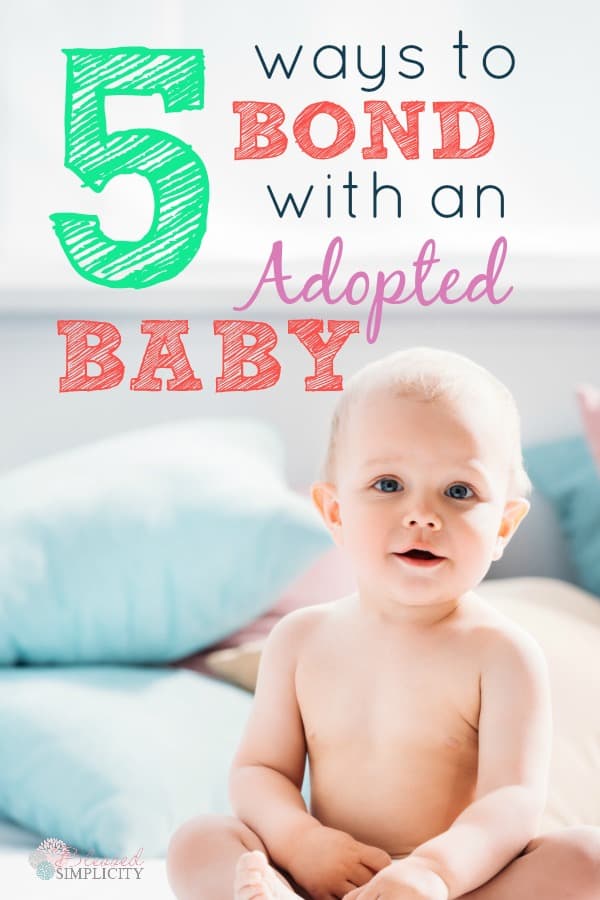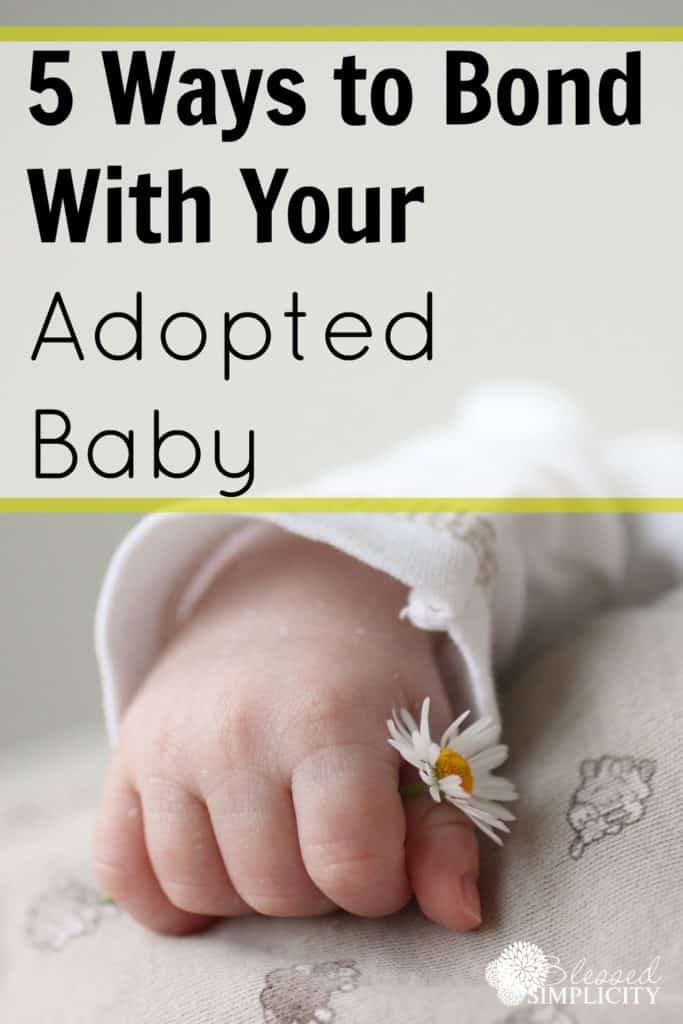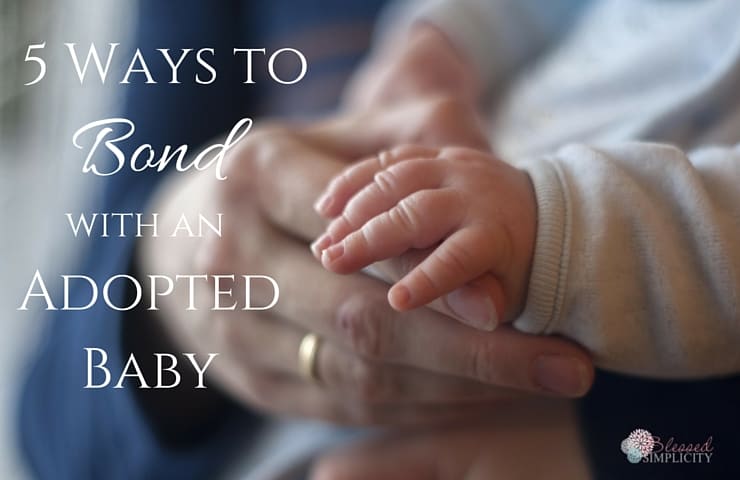Ways to Bond with an Adopted Baby
Worried you will not be able to bond with an adopted baby? Use these five tips to enhance the bonding experience with you and your adopted baby or a baby in foster care.

*This post may contain affiliate links.
Four of our six children came to us through the beautiful miracle of adoption. Two of the four were infants and two were two years old and desperately needed attachment. Bonding with an adopted child and meeting their needs is critical for the child’s emotional development. Finding purposeful ways to bond with an adopted baby can reduce or prevent the effects of reactive attachment disorder later on.
Five Ways To Bond With an Adopted Baby
Kangaroo Care
Kangaroo care, often practiced in Neonatal Intensive Care Units (NICU), is a method of holding a baby that involves skin to skin contact. The baby, who is naked except for a diaper and a piece of cloth covering his or her back (either a receiving blanket, baby wrap or the parent’s clothing), is placed in an upright position against a parent’s bare chest. This snuggling of the infant inside the pouch of their parent’s shirt, much like a kangaroo’s pouch, led to the creation of the term “kangaroo care.”
According the the Cleveland Clinic, the benefits of kangaroo care to the baby include:
- Stabilization of the baby’s heart rate
- Improved (more regular) breathing pattern
- Improved oxygen saturation levels (an indicator of how well oxygen is being delivered to all the infants organs and tissues)
- Gain in sleep time
- More rapid weight gain
- Decreased crying
- More successful breastfeeding episodes
- Earlier hospital discharge
The benefits of kangaroo care to the parents include:
- Improved bonding, feelings of closeness with their babies
- Increased breast milk supply
- Increased confidence in ability to care for their babies
- Increased confidence that their babies are well cared for
- Increased sense of control
Note: Kangaroo care and its benefits are not only for the hospital setting. Securing the bond with your adopted baby goes on for months. Take every opportunity to practice Kangaroo care at home.
Eye Contact
There is a lot of talk in the media about a baby’s ability to maintain eye contact. The inability to maintain eye contact has been noted as an early sign of autism. However, eye contact with a baby is far more important than just its use as a marker. When babies make eye contact with their parents an emotional connection is established. This mutual gaze is shared communication. It establishes with the baby who is meeting his needs, and consistency helps to establish trust.
Tips:
- Hold your baby in a comfortable position
- Allow your baby to look away. This is how he organizes his thoughts.
- Wait for your baby to return to your gaze
- Stay calm and relaxed. Your baby will sense your mood.
Baby Wearing
Baby wearing is sometimes considered a more “crunchy” parenting practice, but there are may studies that show the benefits of baby wearing for both the mother and the infant. Since in-arms parenting meets your baby’s needs for warmth, comfort, and access to breastfeeding, babies cry less and spend more time in a quiet, alert state. While in this state they are better able to learn about their environment and bond with caregivers.
Baby wearing is not a new idea, but has been a common practice in many cultures for centuries. It should be no surprise that it works just as well when adapted for modern times. Modern day baby wearing is often facilitated with a baby wrap, baby sling or a pack style carrier.
Note: As long as you can carry them, toddlers also enjoy being worn, and benefit greatly from interacting with others at eye-level instead of being looked down upon in a stroller.
Reading Aloud
Reading aloud to your baby exposes the baby to the sound of your voice, which is soothing for him. For an adopted baby, reading aloud allows your baby to become increasingly familiar with your voice. It also develops a pattern of consistency. A recent study in the Journal of Developmental and Behavioral Pediatrics found that reading to babies in the NICU can help parents develop the same feelings of intimacy that parents of healthy newborns cultivate in the days and weeks after a baby’s birth.
It really doesn’t matter what books you read to your baby. The idea is really that they consistently hear the sound of your voice and associate that voice with safety and their needs being met. However, if you need ideas for great books to read to babies, I share some of our favorites here.
As an added bonus, studies have also shown that children who were read to as newborns have a larger vocabulary, as well as more advanced mathematical skills, than other kids their age.
Bedding Close
Bedding close essentially means sleeping in close proximity to your child. It may be in the same bed or just in the same room. Some families prefer a co-sleeping or bed sharing arrangement. The American Academy of Pediatrics recommends that babies sleep in the same room as mother, on separate sleeping surfaces, to reap the benefits of nighttime attachment. Whether co-sleeping or simply sleeping in the same room, there are many benefits to bedding close.
- Babies needs can be met quickly, sometimes without the baby fully waking.
- Parents often get more sleep.
- Babies often get more sleep.
- If you are nursing your adopted baby, breastfeeding at night helps to maintain your milk supply.
- Sleeping in the same room as your baby reduces the risk of SIDS by as much as 50% [AAP].
- No nighttime separation anxiety. Reducing anxiety of any kind is ideal when bonding.
- Co-sleeping is infants virtually never startle during sleep and rarely cry during the night, compared to solo sleepers who startle repeatedly throughout the night
Bonding Is About Meeting Needs
Bonding with an adopted child of any age is really all about identifying and meeting the child’s needs. If you have adopted or are considering adoption, I encourage your to read books on attachment and bonding.
Many times, adopted children have experienced trauma in some form that either increased their needs due to injury or exposure or their needs were never met as a result of neglect. Establishing that you are a consistent source of met needs for your child will be the foundation of forming a lasting bond.
For more information about adoption and foster care, join the discussion in my facebook group here and like my blog page here for our latest posts. You can also sign up for my newsletter below and get a free copy of my home study checklist.




Such wonderful tips! We don’t have any adopted babies in our family, but I certainly enjoyed this. Thanks for sharing with SYC.
hugs,
Jann